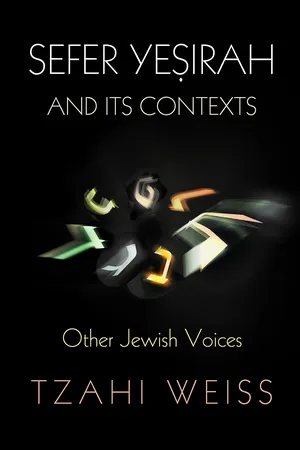
- 208 pages
- English
- PDF
- Available on iOS & Android
About This Book
Sefer Ye?irah, or "Book of Formation, " is one of the most influential Jewish compositions of late antiquity. First attested to in the tenth century C.E. and attributed by some to the patriarch Abraham himself, Sefer Ye?irah claims that the world was created by the powers of the decimal number system and the twenty-two letters of the Hebrew alphabet. This short, enigmatic treatise was considered canonical by Jewish philosophers and Kabbalists and has fascinated Western thinkers and writers as diverse as Leibnitz and Borges. Nonetheless, Sefer Yesirah is nearly impossible to contextualize, mainly owing to its unique style and the fact that it does not refer to, nor is it referenced by, any other source in late antiquity. After a century and a half of modern scholarship, the most fundamental questions regarding its origins remain contested: Who wrote Sefer Ye?irah? Where and when was it written? What was its "original" version? What is the meaning of this treatise?In "Sefer Ye?irah" and Its Contexts, Tzahi Weiss explores anew the history of this enigmatic work. Through careful scrutiny of the text's evolution, he traces its origins to the seventh century C.E., to Jews who lived far from rabbinic circles and were familiar with the teachings of Syriac Christianity. In addition, he examines the reception of Sefer Ye?irah by anonymous commentators and laypeople who, as early as the twelfth century C.E., regarded Sefer Ye?irah as a mystical, mythical, or magical treatise, thus significantly differing from the common rabbinic view in that period of the text as a philosophical and scientific work. Examined against the backdrop of this newly sketched historical context, Sefer Ye?irah provides a unique and surprising aperture to little-known Jewish intellectual traditions of late antiquity and the early Middle Ages which, despite their distance from the rabbinic canon, played a vital role in the development of medieval Jewish learning and culture.
Frequently asked questions
Information
Table of contents
- Cover
- Contents
- A Note on Transliteration of the Hebrew Alphabet
- Introduction
- Chapter 1. Discussions About Alphabetical Letters in Non-Jewish Sources of Late Antiquity
- Chapter 2. The Creation of the World from the Letters of the Ineffable Name
- Chapter 3. The Creation of the World from Twenty-Two Letters and the Syriac Context of Sefer Yeṣirah
- Chapter 4. Sounds of Silence: Sefer Yeṣirah Before the Tenth Century
- Chapter 5. Reevaluating the Scientific Phase of Sefer Yeṣirah
- Epilogue
- Appendix 1. Sefer Yeṣirah and the Early Islamic Science of Letters
- Appendix 2. Sefer Yeṣirah’s Long Version, According to Ms. Vatican 299/4, 66a–71b, with the English Translations of Peter A. Hayman
- Appendix 3. The Midrash About Sefer Yeṣirah and Ben Sira, According to Ms. Vatican 299/4, 65a–66a
- Notes
- Bibliography
- Index
- Acknowledgments